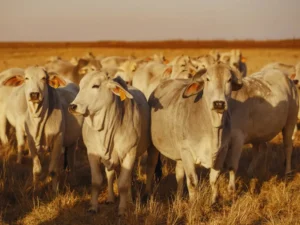The Role of RFID in Enhancing Livestock Traceability: A Path Toward Modernizing the Cattle Industry
Summary
The U.S. cattle industry has seen a growing push for RFID (Radio Frequency Identification) technology to track livestock throughout the supply chain. Though some stakeholders have expressed concerns over the cost and implementation of RFID mandates, the benefits of this technology are undeniable. RFID enables real-time tracking of cattle, monitors health and disease, prevents theft, and ensures transparency across the supply chain. Despite challenges, the adoption of RFID could offer long-term gains for producers, consumers, and the broader cattle industry.

The Evolution of RFID in the Cattle Industry
Early Adoption and Government Initiatives
Since 2015, the U.S. Department of Agriculture (USDA) and the Animal and Plant Health Inspection Service (APHIS) have conducted pilot programs to evaluate the effectiveness of RFID in tracking cattle from ranches to slaughterhouses. These initiatives aimed to enhance disease traceability and improve the efficiency of the livestock supply chain. The USDA initially proposed a nationwide RFID cattle-tracking program that would require RFID tags for all animals moving interstate by 2023. However, this plan has faced delays due to industry pushback and administrative changes.
RFID Technology’s Potential to Revolutionize the Livestock Supply Chain
Benefits of RFID for Disease Traceability
One of the primary benefits of RFID is its ability to monitor and prevent the spread of diseases within the cattle industry. By tagging cattle with RFID chips, ranchers and veterinarians can easily track the health history of each animal, from vaccinations to disease treatments. This capability allows for quick containment of disease outbreaks, ensuring the safety of both cattle and consumers.
Efficiency Gains for Livestock Producers
RFID technology can also streamline daily operations for livestock producers. By automating tasks such as feeding, health monitoring, and breeding record-keeping, RFID eliminates the need for time-consuming manual processes. Additionally, RFID systems can store a wealth of data, including veterinary records, breeding histories, and inoculations, which can be easily accessed throughout the supply chain.

Overcoming Challenges in RFID Adoption
Financial Concerns Among Producers
Many cattle producers, particularly smaller operations, have expressed concerns about the costs of implementing RFID technology. Critics argue that the expense of purchasing tags, readers, and the infrastructure to support RFID is prohibitive, especially during economic downturns like those caused by the COVID-19 pandemic. However, proponents of RFID believe that these initial costs will be offset by long-term savings and increased operational efficiency.
Government Support and Cost Sharing
To ease the burden on producers, the USDA has proposed a cost-sharing program that offers financial assistance for RFID implementation. Under this program, the government would subsidize 50 cents per RFID tag, and cooperative agreements with states would help fund the purchase of RFID readers for veterinarians and livestock businesses. These measures are designed to facilitate a smoother transition to RFID and ensure that producers of all sizes can participate.
RFID’s Impact on Security and Market Opportunities
Preventing Theft and Poaching
RFID technology provides a digital ID for each animal, making it easier to track cattle movements and prevent theft. This is particularly important in rural areas where cattle rustling remains a problem. RFID tags can be linked to monitoring systems that alert producers when animals leave designated areas, reducing the risk of loss due to theft or escape.
Expanding International Market Opportunities
Many countries that import beef, particularly in Europe and Asia, require detailed health and traceability records for livestock. By adopting RFID systems, U.S. cattle producers can meet these international requirements, expanding their access to global markets. RFID-based traceability not only protects animal health but also enhances the reputation of U.S. beef on the international stage.
Frequently Asked Questions
- Why is RFID technology important for the cattle industry?
RFID technology enhances disease traceability, improves operational efficiency, and ensures transparency throughout the livestock supply chain, benefiting producers and consumers alike.
- What are the costs associated with implementing RFID in cattle operations?
Initial costs include purchasing RFID tags, readers, and infrastructure. However, the USDA offers a cost-sharing program that covers 50 cents per tag, reducing the financial burden on producers.
- How does RFID help prevent cattle theft?
RFID tags provide a unique ID for each animal, allowing producers to monitor cattle movements in real-time and prevent theft or unauthorized movement.
- What are the long-term benefits of RFID adoption in the cattle industry?
RFID systems streamline operations, reduce labor costs, enhance disease monitoring, and open new international market opportunities by ensuring compliance with traceability standards.
Comparison of RFID and Traditional Cattle Identification Methods
| Feature | RFID | Traditional Ear Tags |
| Traceability | Real-time tracking, disease history | Limited, manual record-keeping |
| Operational Efficiency | Automated data capture | Manual data entry, prone to errors |
| Cost | Higher initial investment, long-term savings | Lower upfront cost, more labor-intensive |
| Security | Theft prevention through digital monitoring | Difficult to track lost or stolen cattle |
| Market Access | Compliant with international traceability standards | Limited access to global markets |
This table highlights the advantages of RFID technology over traditional cattle identification methods. Though RFID requires a higher upfront investment, its long-term benefits include improved traceability, operational efficiency, and expanded market opportunities, making it a valuable tool for the future of livestock management.
